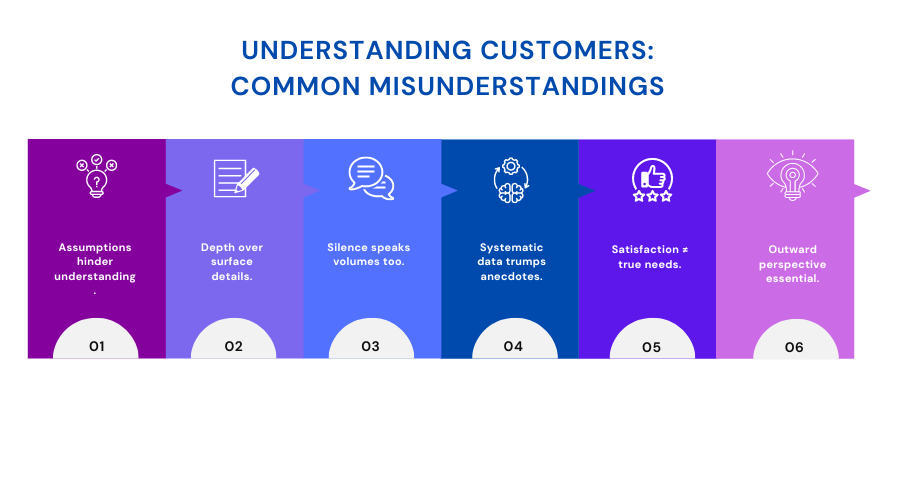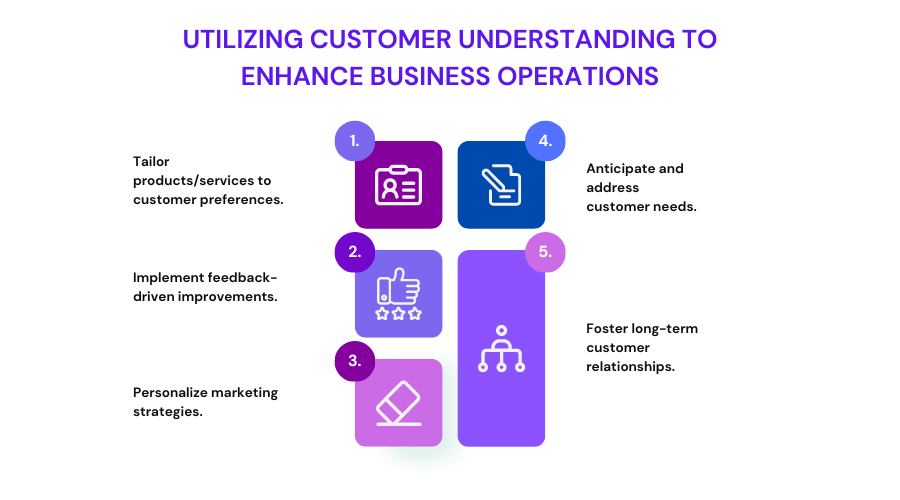How to Understand Your Customers Deeply

Connecting with customers on a deeper level is the holy grail for many businesses. But it’s easier said than done.
According to a survey by Salesforce, 84% of customers say being treated like a person, not a number, is very important to winning their business. Yet only 27% of customers feel understood by the brands they interact with.
There needs to be more clarity between what customers want and what businesses deliver.
So, how can you truly understand the people who matter most – your customers?
What Most People Get Wrong About Understanding Customers
Many businesses fall into common traps when trying to understand their customers better.
Let’s understand what are the main reasons why these businesses fail to understand their customers.
Relying on Assumptions Rather Than Data
It’s tempting to make assumptions about who your customers are and what they want. You need to gather complex data to guess based on biases and mental shortcuts.
Focusing on Demographics Over Psychographics
Knowing surface details like age, gender, location, etc., doesn’t reveal enough. It would help if you had more profound insights into mindsets, values, desires, and behaviors.
Only Listening to Your Loudest Customers.
Squeaky wheels stand out but aren’t representative. Make sure to pay attention to silent segments, too.
Favoring anecdotal feedback over aggregated feedback
The occasional feedback is helpful, but you must gather data more systematically for a narrow perspective.
Stopping at Satisfaction Metrics Versus Understanding Needs
Knowing broad satisfaction rates has value but falls short of unpacking specific underlying needs driving your customers’ actions.
Relying on Inward Thinking Rather Than Outward Focus
It’s natural to look inward, but you need processes to keep looking outwards from the customer’s point of view, not just your own.
The key is balancing empathy with data – using quantitative and qualitative insights to build a 360-degree view of your customers. Let’s examine how.

How to Understand Your Customers Deeply
According to Mr Sam Walton (Travis Biggert)
There is only one boss. The customer. And he can fire everybody in the company, from the chairman on down, simply by spending his money elsewhere.
Believe it or not, we live in an era where it’s more than essential to run a tight ship, survive, and thrive.
Worried? Well, don’t keep reading, and we will unveil a few ways to remedy this.
Here are five steps to truly understand customers at a deeper level:
Step 1: Gather Qualitative Customer Insights
Qualitative insights reveal how customers think and feel. Some techniques to try:
- Interviews: Have in-depth conversations with carefully selected customers. Get their stories.
- Focus groups: Facilitate discussions with small customers to hear their perspectives.
- Customer advisory boards: Form a board of volunteer customers to collect feedback regularly.
- Site visits: Go onsite to where customers are and observe them in their natural habitat.
- Ethnographic research: Embed yourself as a researcher in customers’ lives to gain empathy.
- Customer support insights: Analyze support tickets, calls, chat logs, and social media interactions.
- User testing: Watch how customers use your product and where they struggle.
- Diary studies: Ask customers to self-report their interactions, thoughts, and feelings over time.
The goal is to hear directly from customers – in their own words – about their real-life experiences, pain points, mindsets, needs, desires, and more on an ongoing basis.
How to Gather Qualitative Customer Insights Using Chisel:
- Chisel allows you to collect qualitative customer feedback through their feedback collection tool. This will enable you to gain deeper insights into customer opinions, experiences, and needs that often don’t come through in quantitative answers alone.
- To gather these insights, set up a feedback collection form in Chisel. Keep the questions open-ended to elicit detailed responses. Ask customers about their journey using your product, both the positive and negative experiences. Inquire about features they want to see added or improved.
- Once the form is ready, you can share it with customers through email, your website, or social media. Asking for their honest feedback will help build goodwill. As responses come in, Chisel automatically captures them and organizes them for your review.
- The Chisel team reviews qualitative responses to identify common themes, including frequently mentioned pain points or desired features. They synthesize this unstructured data into succinct findings that provide a deeper understanding of your customers than quantitative data alone.
- Armed with these rich customer insights, you can make more informed strategic decisions about your roadmap, product design, and marketing approach. The goal is to apply what you learn to create an even better customer experience. Chisel helps quickly transform user feedback into actionable guidance for positively evolving your business.
Step 2: Collect Quantitative Customer Data
While qualitative insights reveal, you need quantitative data to spot more prominent trends. Ways to get numerical data include:
- Surveys: Ask structured questions to many customers to get statistically significant results.
- Website analytics: Use tools like Google Analytics to analyze visitor behaviors on your site.
- A/B testing: Try variations of design or messaging to see what performs better.
- Sales data analysis: Review historical transaction data for trends and patterns.
- Net Promoter Score: Measure customer satisfaction and loyalty levels with a standardized metric.
- Customer metrics: Track key metrics like retention, lifetime value, acquisition costs, etc.
- Feedback forms: Collect ratings, reviews, and feedback data to uncover preferences.
- Market research: Leverage research firms that conduct large-scale surveys and studies.
The goal is to complement anecdotal insights with complex data about how many customers think or behave in a certain way.
How to Collect Quantitative Customer Data Using Chisel:
- Chisel allows you to gather quantitative customer data through online surveys. This statistical data provides insights into customer satisfaction levels and the perceived value of certain features.
- To collect quantitative data, start by creating a survey in the tool. Include scaled rating questions like “How likely are you to recommend our product to a friend?” along with multiple choice questions about usage frequency and demographics.
- Once your survey is ready, embed the QR code or share a link on your website, in the app, or via email campaigns. Collecting a large enough sample size will help ensure the data is statistically significant.
- As customers complete the survey, Chisel automatically captures and aggregates their responses. This allows you to quickly analyze metrics like Net Promoter Scores usage patterns trends over time. It also performs statistical analysis to find correlations between different data points.
- Armed with clear quantitative metrics, you can identify performance gaps, uncover trends in customer segments, and pinpoint where to focus product improvements. Quantitative customer data empowers evidence-based decisions that strengthen customer relationships and business growth.
Step 3: Map Customer Personas and Journeys
With qualitative and quantitative learnings gathered, you can start clustering customers into personas and mapping everyday journeys.
Personas are detailed archetypes that represent different customer segments. Key elements include:
- Demographic profile
- Psychographic profile
- Goals and challenges
- Values and motivations
- Behaviors and habits
Journey maps illustrate customers’ significant experiences with your brand over time and across channels. They outline:
- Different touchpoints
- Pain points and emotions at each stage
- Moments that matter most
With personas and journeys mapped out, you can pinpoint where fundamental needs are unmet and driving disconnects.
How to Map Customer Personas and Journeys Using Chisel:
- Chisel allows teams to visualize key customer segments and map their end-to-end experiences. This provides a critical context for strategic decision-making.
- First, analyze all available qualitative and quantitative customer data in this tool. Look for common themes, behaviors, and attributes that help cluster customers into distinct personas. Document each persona’s goals, pain points, and characteristics.
- With personas identified, map out their typical journeys interacting with your business. Highlight each touchpoint and annotate the emotions, considerations, and obstacles customers face. Illustrate how easily or frustratingly they progress toward completing tasks.
- Chisel’s drag-and-drop interface makes visualizing persona maps and experience journeys simple. Different shapes and colors represent the various personas and stages of their processes. Linking steps show the interconnection between events.
- Well-crafted persona maps and customer journey maps help teams understand customer motivations more deeply. They also reveal opportunities to streamline experiences, better meet needs, and remove frustrations. This customer-centered insight is invaluable for ensuring strategic plans and new features truly serve clients.
Step 4: Apply Human-Centered Design Thinking
With more profound insights into actual people, adopt a human-centered design approach to serve customers better. Key principles:
- Empathize: Focus on customers’ problems, not just business goals. See issues from their perspective.
- Define Frame problems as concrete points of pain for target users.
- Ideate: Brainstorm solutions that genuinely connect with user needs.
- Prototype: Start creating experimental solutions while they’re still imperfect.
- Test: Try out solutions directly with users to refine feedback-based approaches.
Keep iterating based on continuous customer input. Favor simple but meaningful solutions over complex ones. The human experience is what matters most.
How to Apply Human-Centered Design Thinking Using Chisel:
- Chisel facilitates applying human-centered design (HCD) principles to ensure solutions genuinely meet customer needs. HCD is an approach that prioritizes understanding the human perspective through empathy, collaboration, and prototyping ideas for feedback.
- When using Chisel for HCD, gather deep customer insights through qualitative research like interviews and feedback forms. Synthesizing these in Chisel helps define the core problem to solve.
- Teams can then brainstorm possible solutions directly in its whiteboarding function. This allows collaborating visually to sketch concepts. It encourages divergent, creative thinking without pre-judging ideas.
- The most promising ideas are refined into digital or physical prototypes using Its project workflows. Prototypes are then shared with customers for real-time feedback through embedded forms. Their input further clarifies requirements.
- Iterating prototype designs based on customer input helps ensure the eventual solution meets human needs rather than simply fulfilling technical requirements.
- By facilitating qualitative research, ideation, prototyping, and customer testing, Chisel supports every stage of HCD. This process leads to innovative solutions that reduce frustration and create meaningful impact for businesses and users.
Step 5: Operationalize Customer Centricity Company-Wide
Refrain from keeping customer understanding confined to marketing. Spread this intelligence company-wide to align everything to the customer:
- Training: Teach all employees, not just frontline staff, about personas and journeys. Foster direct interactions between customers and cross-functional teams.
- Processes: Review workflows through the lens of customer needs. Identify friction points.
- Metrics: Tie customer-focused KPIs to individual and team incentives.
- Technology: Evaluate tools through the user experience lens. Procure solutions that unify data.
- Content: Produce content that speaks directly to customer concerns in their language.
- Product development: Include customer perspectives from ideation to test phases.
- Leadership: Instill a mindset and culture focused on the customer across the organization.
Ongoing customer insights should directly inform every aspect of operations. Siloes prevent you from being nimble in addressing evolving needs.
How to Operationalize Customer-Centricity Company-Wide Using Chisel:
- To truly embed customer-centric values, teams need access to consistent customer insights and alignment on strategic priorities. Chisel helps companies operationalize customer obsession at scale.
- First, customer research and feedback from all contact points are centralized in the software. This provides a single source of truth across departments.
- Roadmaps in the tool ensure everyone understands top company goals and how initiatives relate to delighting customers. Team OKRs can then be set to contribute toward shared objectives.
- Access to consolidated data and roadmaps helps tell a cohesive story to inform decisions. With visibility into customer needs and strategic plans, even support staff can shape their work to add client value.
- Teams share progress and feedback in its discussion features, spotting relationships across efforts. This fosters collaboration around shared metrics like effortless customer experiences.
- By uniting quantitative and qualitative insights, aligning goals, and facilitating company-wide cooperation, it empowers organizations to put the customer at the heart of everything they do. This results in seamless experiences that enhance loyalty.
How to Use Your Understanding of Customers to Improve Your Business
When armed with 360-degree knowledge of your customers, you can make improvements across the business:
- Messaging: Craft more relevant messaging and content that resonates with each audience segment.
- Product: Identify new features or upgrades customers want most. Cut ones that don’t get used.
- Service: Recognize pain points in the experience and improve processes. Empower support teams.
- Pricing: Price according to the value you provide customers. Offer tiered plans aligned to needs.
- Sales: Reps can take more tailored approaches to each prospect immediately.
- Marketing: Create campaigns focused on different buyer stages and journeys. Personalize nurturing.
- Innovation: Uncover and develop new solutions for your most underserved customers.
- Partnerships: Look for third parties filling gaps in your customer experience.
- Training: Build employee empathy by sharing personas and scenarios reflecting customer realities.
- Hiring: Assess candidates on customer-centric mindsets beyond just skills.
When decisions get made through the lens of maximizing value for customers, everything improves. Their needs become the true north guiding your business.

Key Takeaways
- Avoid common mistakes like relying on assumptions instead of data when understanding customers.
- Combine qualitative insights and quantitative data to build 360-degree views of customer segments.
- Map detailed personas and journeys to pinpoint pain points and unmet needs.
- Adopt human-centered design thinking to create solutions focused on the customer experience.
- Spread customer intelligence company-wide to align strategies, processes, technologies, and people to evolving needs.
- Use your deep knowledge of customers to guide improvements in offerings, experiences, and operations.
Understanding your customers deeply takes work but pays off exponentially. You not only better serve customers, you build lasting competitive advantage. With so much riding on the customer relationship, dedicating resources to connect with their needs and mindsets truly is an investment that yields some of the highest returns possible.
Put these steps into practice to become a customer-led organization. Your customers will feel the difference, as will your bottom line.
